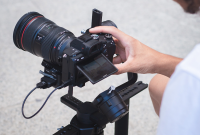Keeping Your Digital Camera From Shaking
If you have ever seen a photo that seems to be fuzzy, it is most likely because the camera was disturbed when the image was being shot. When using classic photographic film cameras, it was only after the negatives and positives were developed that the error was discovered. A digital camera, on the other hand, allows the acquired picture to be viewed instantly on the LCD screen, and if the image has been rattled, it may be rejected and replaced with a fresh one.
Digital camera shaking is prevalent among first-time users of digital cameras. New users have not completely grasped the concept that the shutter-release button must not be hit twice, but rather two steps down, which is the case in most cases for beginners. The first step locks in the focus and exposure, while the second step actually shoots the picture! In order to avoid blurry pictures from the digital camera shaking when pushing the button, it is necessary to press the button smoothly.
Additionally, the shutter speed has a significant impact on how blurry a photograph seems. Essentially, shutter speed refers to how long a digital camera’s shutter stays open in order to enable light to reach the digital camera sensor. Seconds or fractions of a second are used to measure the time. The exposure of a photograph is determined by the combination of the lens aperture and the shutter speed. To minimize overexposure while shooting at a slow shutter speed, a tiny aperture (high F-stop value) is required. When using a slow shutter speed of less than 1/60th of a second, overexposure may be effectively prevented. Nevertheless, the digital camera is more likely to shake, resulting in a wobbly image.
In order to prevent digital camera wobble, a tripod is highly recommended. Close-ups, landscape and panning images, timed exposures, shooting at slow shutter rates, and capturing photos in low or weak light are all possible with this lens, which is most often utilized by sports photographers who use long telephoto lenses. Taking photographs of a fast-moving subject, such as sports or animals, puts the photographer’s expertise and equipment to the test. In such situations, camera shaking is most likely to occur, therefore a monopod or a tripod should always be utilized. When digital cameras are placed on tripods, they have a tendency to reduce camera shaking and provide clear images.
Image stabilization is a fantastic function that can be found in almost all high-end digital cameras available today (IS). An anti-shake and vibration reduction technique, image stabilization (IS) is often found in digital cameras with long telephoto zooms of up to 10X and 12X. If the camera shakes somewhat, a slow shutter speed is utilized, the photography is done in low light circumstances, or a tripod is not used, clear shots may still be acquired using IS. IS was initially intended for use with video camera systems. It is currently available in interchangeable lens digital cameras, as well as consumer and professional digital cameras that utilize optical image stabilization to improve picture quality. Sports and wildlife photographers employ a tripod and image stabilization technology combined to get the sharpest possible images. Yet, many other photographers switch off the IS function while using a tripod to achieve the sharpest possible images.
The use of the strategies described above may help to remove or reduce the appearance of digital camera wobble. In the absence of tripods or image stabilization technology, the basics of getting a decent photo have proven to be the most effective method of eliminating camera wobble.
It is necessary to adhere to the fundamentals of excellent photography. It is recommended that you hold the digital camera with both of your hands. Maintain a comfortable distance between your legs, with your knees slightly bent forward. If at all feasible, your elbows should be braced against your body, and your body should be braced with some kind of support. In most cases, you should use the viewfinder rather than the LCD screen to frame and compose your photographs. If you want to avoid any movement of the chest and hands, you should softly push the shutter release button two steps down and hold your breath at that time to prevent any movement of the chest and hands. You may be certain that your digital camera will not wobble and that no image will be blurred if you follow this fundamental method of excellent shooting.



